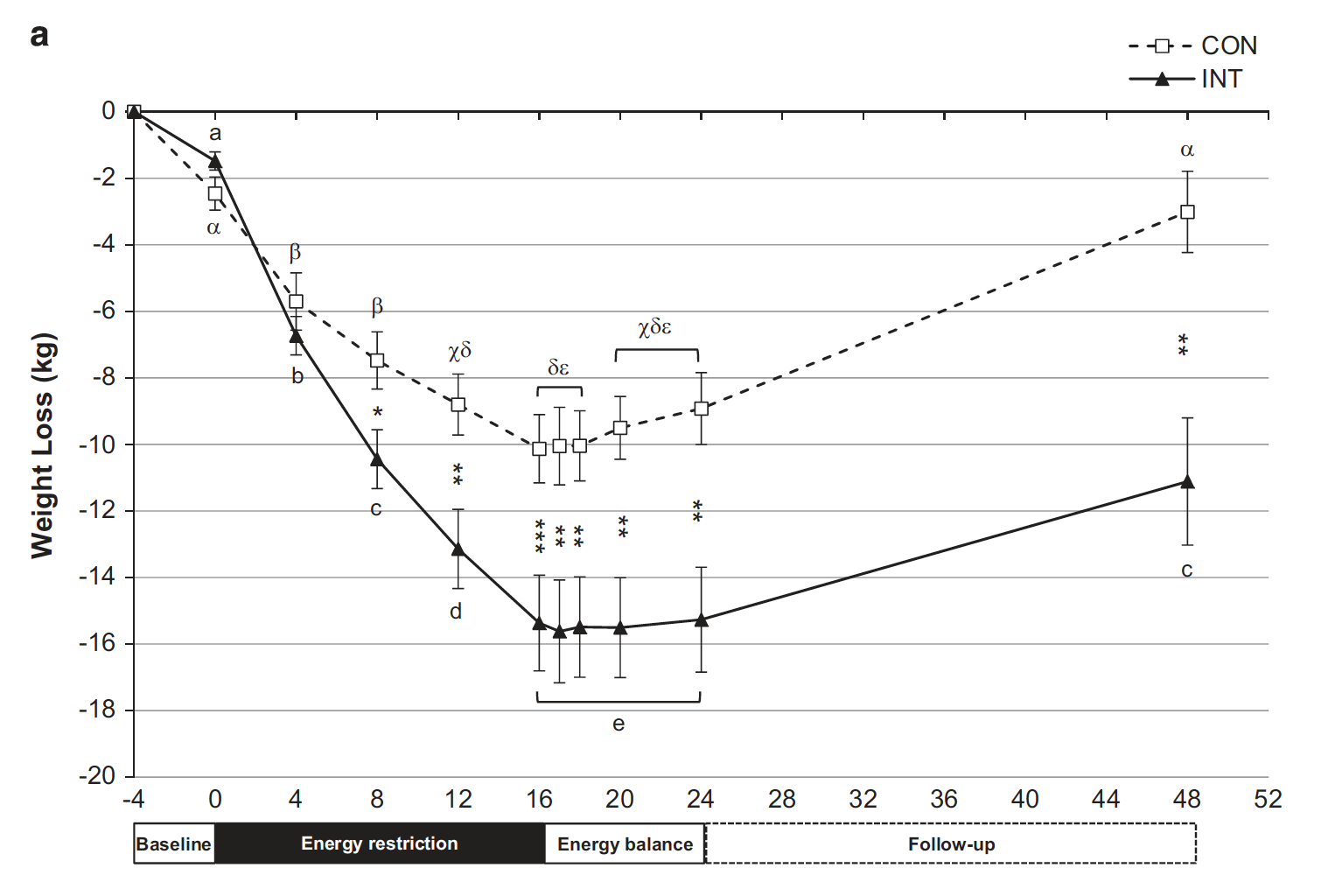Adaptive Thermogenesis
One of the main difficulties in losing significant amounts of weight is that the body responds to energy restriction through a number of biological and behavioral compensatory mechanisms that reduces our “resting energy expenditure” or our RER.
In other words, when we diet, the body naturally adapts and begins to burn less calories, ultimately leading to a plateau in fat loss. In the nutritional science world, this is called “Adaptive Thermogenesis.”
Annoyingly for both clients and nutrition coaches, this effect occurs relatively quickly, even in individuals with significant weight to lose.
Overcoming Adaptive Thermogenesis "Probs"
A 2018 study looked to overcome the Adaptive Thermogenesis obstacle with a novel approach where subjects were given a controlled “break” from their caloric restriction. This study is where the MATADOR approach ie Minimizing Adaptive Thermogenesis And Deactivating Obesity Rebound was born.
Here’s how it worked...
- The “Control” group (CON) was placed in a continuous energy restriction of 33% of their resting energy expenditure.
So, just as an example, if they burned 2000 calories, then their “diet” consisted of 1333 calories. This is a pretty big deficit! - The “Intermittent Energy Restriction” (INT) group was placed in the same 33% deficit; however, every 2 weeks, they were taken OUT of their caloric restriction and placed at calorie equilibrium.
Using the same example as from the CON group, the same individual would have 2 weeks at 1333 calories, followed by 2 weeks at 2000 calories.
(Please note: They were NOT given freedom to eat as much as they want. Also, this is NOT the same thing as intermittent fasting… not even close.)
So What Happened?
The study looked at a number of parameters, but the most critical one was weight loss. In this parameter, the INT group vastly outperformed the CON group with a 47% greater weight loss over 16 weeks. This is a massive difference.
What is even more amazing is that a 6-month follow up, the INT group had lost an astonishing 80% more weight than the CON group.

It’s clear that the 2-week controlled “maintenance” blocks were critical in the superior performance of INT group over the CON group. The authors suggest that the 2 week blocks of energy equilibrium function as “metabolic rest periods” which prevented the adaptive thermogenesis normally seen in patients in large calorie deficits.
What Can We Learn From This Study?
So, while this study is groundbreaking in showing a superior way to lose weight than conventional dieting, I think there are some red flags that can affect this protocol's sustainability and ultimately results:
- DEFECIT
A 33% calorie deficit is massive. Think of all the food you eat in a day and then say goodbye to 1/3 of it… no thank you. I’ve seen people attempt this and typically it leads to binge eating issues.
While the "break" from a deficit seems to be the "key" to success, some really struggle being in a deficit in the first place. Again, this can sometimes lead to more problems or counter-intuitive behavior. - CONTROL
Keep in mind that the participants in this study were provided much of the food that they were supposed to eat and had constant oversight from a team of nutritionists. That’s not really ever going to happen in the real world.
One thing we know to be true is that whatever protocol we choose for our diet HAS to be sustainable otherwise it’s just going to end up in the “FAIL” bucket along with all the other extremist approaches out there.
Other Key Takeaways
That said, there are some really great things that we can learn from this study and apply to ALL approaches.
The biggest takeaway being that breaks from your "diet" are not just good for your mental health, but clearly good for your physical and metabolic health as well.
Secondly, when you do take a “break” from your calorie deficit, it should be in a controlled fashion. Ad libitum eating generally will drastically reduce the success of your diet overall.
How To Make the MATADOR Protocol Work For You?
If you feel comfortable adjusting your own macros, I would NOT recommend starting with a 33% calorie deficit from your metabolic maintenance numbers. It's pretty extreme, and in my experience, most people will quit pretty early. I might instead suggest a smaller initial deficit, something between 15 and 20%.
As an example, if someone’s RER is 2000 cals, then their deficit numbers would be somewhere between 1600 and 1700 cals. This feels much more reasonable than 1333 cals.
Secondly, don’t be dogmatic about 2 week intervals. One could easily change either the time in a calorie deficit from 2 weeks to 10 days or even just 7 days… OR you could adjust how long your metabolic maintenance period is as well.
Seek Out a Professional
In the end, I would STRONGLY suggest the help of a professional while implementing the MATADOR diet.
Making rational decisions about what your two sets of calories can be rather difficult when you’re working on your own nutrition, most people try to cut calories TOO STEEPLY and for way TOO LONG.
Secondly, there may be a health reason behind why you might NOT be a good candidate for this protocol or other weight loss protocols - again, usually best to get a professional involved.
The M2 Approach
At M2, we’ve implemented a modified version of the MATADOR protocol and are having HUGE success in helping clients lean out.
Contact Us here to learn more about our program or to find out if you're a good candidate for this approach!
Ready to Learn More With M2?
We're excited to launch the first course in The M2 Certification Series, which will be the Gut Biology Course! Let us know you want to be on the list to get first access and early bird pricing!




